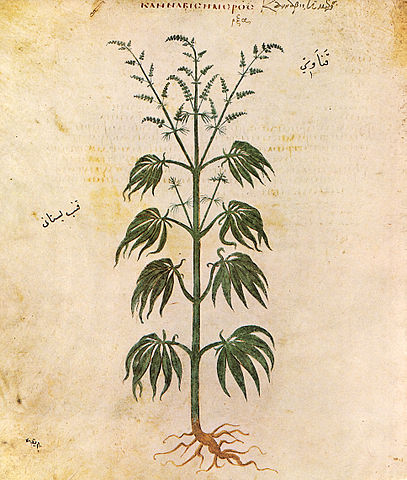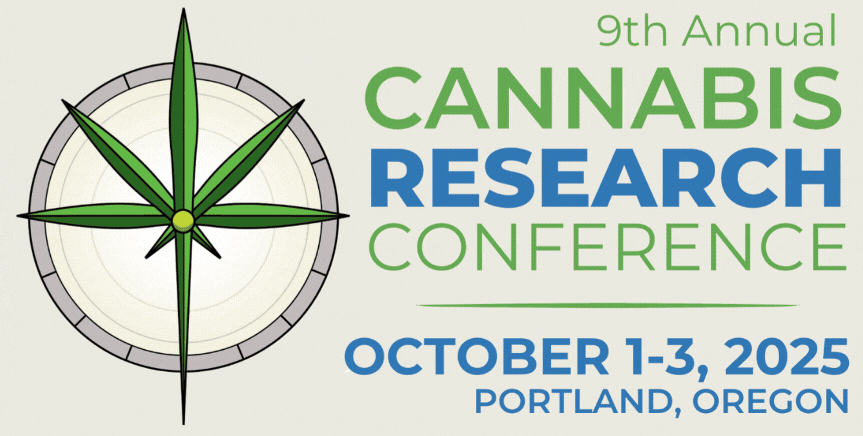Journal of Cannabis Research: A Short History
Published in Chemistry, Sustainability, and Pharmacy & Pharmacology


Vienna Dioscurides c. 512 CE
Cannabis has a long and ancient history in society and medicine. Evidence for entheogenic use dates back more than 2,500 years and applications in traditional medicine span centuries. During the 1900s, most countries banned the growth, sale and consumption of cannabis. However, according to the UN World Drug Report, cannabis remained very popular being "the world's most widely produced, trafficked, and consumed drug in the world in 2010."
There are more than 500 known compounds in the cannabis plant, with tetrahydrocannabinol (THC) and cannabidiol (CBD) being the most well-known. Medical cannabis refers to the use of these products in directly treating disease, with various immunological, neurological, psychological and other applications having been discovered to date.

images on Cannabis and Medical Cannabis regulation
The aforementioned regulation has limited the amount of clinical research that's been conducted into medical cannabis, but as of today, there are 49 countries and 39 US states (including Washington DC) that permit the use of cannabis for medicinal purposes.
Despite the challenges that remain, knowledge and understanding of the role of cannabis in healthcare is growing. Research is strong in applications for cancer, nausea and vomiting, chronic pain and musculoskeletal pain, anxiety and mental health, inflammation, even products for companion animals. The adverse effects and the public health impacts of more widespread use are also much clearer thanks to national and international surveys.
These advances in cannabis science can be attributed, in part, to organisations such as the Institute of Cannabis Research (Colorado State University–Pueblo, USA), which was created by the Colorado state legislature in 2015 to help fund research and communicate trusted science to the public. They are the sponsors of the Journal of Cannabis Research, which was launched in 2018 to help support this mission and give cannabis scientists and public health/policy experts a central resource for knowledge and dissemination.
|
Journal Impact Factor 2023: 4.1 Number of readers in 2024: 500K |
Submission to 1st decision: 12 days Submission to acceptance: 175 days |
It became clear from the outset that the journal had to be multi-disciplinary. Questions about the cannabis plant and its products had been increasing across dozens of fields: plant biology and agriculture, genetics, biomedical science, public health, public policy, environmental science, commerce and more. Manuscripts were being published in various field-specific journals and gaining traction, but this made it difficult for cannabis scientists to stay abreast of everything relevant to their research. It also made it difficult for researchers to find a suitable home for manuscripts that did not fit neatly into one field.
Journal of Cannabis Research: Aims & Scope
 The Journal of Cannabis Research is a central resource for all these topics, providing updates across each field and encouraging cross-disciplinary discussion that helps cannabis research advance as a whole. The full scope of the journal and our inter-disciplinary approach to cannabis can be found on our About page.
The Journal of Cannabis Research is a central resource for all these topics, providing updates across each field and encouraging cross-disciplinary discussion that helps cannabis research advance as a whole. The full scope of the journal and our inter-disciplinary approach to cannabis can be found on our About page.
Join our Editorial Board!
Supporting authors across each of these areas would not be possible without our international Editorial Board, led by our Founding Editor-in-Chief, David A. Gorelick, MD, PhD (University of Maryland Baltimore, USA). We are fortunate to have some giants of cannabis research supporting the journal. Their knowledge and connections to the field are essential to making sure our diverse manuscripts are judged by the most suitable experts. If this role sounds appealing, then you're in luck! The Journal of Cannabis Research is currently recruiting new Associate Editors and would be pleased to receive your application.
Collections and Calls for Papers
Beyond manuscript review, our editors also help us stay on the leading edge of cannabis science and commission work from authors working on the most exciting and important topics. To this end, the Journal of Cannabis Research recently launched four new collections of key relevance to the field:
-
Non-psychotropic cannabinoids in drug discovery and their therapeutic potential
Exciting clinical and preclinical research on CBD and cannabinoids, including pharmacology and chemical extraction. -
Healthcare professionals and cannabis: knowledge, attitudes, and training
Evaluating the state of knowledge and advising on future developments to ensure medical professionals, particularly non-specialists in cannabis, are equipped to talk to patients. -
New developments in Cannabis sativa science: agronomy, plant biology, and molecular insights
Plant science, agriculture, cultivation and the genetic/transcriptomic features of C. sativa -
Mechanisms of action and potential therapeutic applications of the cannabis plant
The endocannabinoid system and how various molecules derived from cannabis interact with the human body, as well as how interactions can be leveraged for therapy.
The Institute for Cannabis Research is integral to our work. They host monthly webinars, post a monthly newsletter and organise the annual Cannabis Research Conference (this year held in Portland, OR, USA). These are all incredibly valuable resources to a cannabis scientist and, importantly, free to access!

Follow the Topic
-
Journal of Cannabis Research

The Journal of Cannabis Research is an international, fully open access, peer-reviewed journal covering all topics pertaining to cannabis, including original research, perspectives, and protocols. Our goal is an accessible outlet for expert interdisciplinary discourse on cannabis research.
What are SDG Topics?
An introduction to Sustainable Development Goals (SDGs) Topics and their role in highlighting sustainable development research.
Continue reading announcementRelated Collections
With Collections, you can get published faster and increase your visibility.
Non-psychotropic cannabinoids in drug discovery and their therapeutic potential
The exploration of non-psychotropic cannabinoids is crucial for advancing the scientific understanding of their therapeutic potential and applications in drug discovery. As cannabinoid research continues to evolve, we are uncovering the multiple ways in which these compounds, including CBD (cannabidiol), interact either with cannabinoid receptors or with other targets to impact human health. The importance of this research is underscored by the growing interest in medical cannabis, particularly as it relates to cannabinoid therapy for various conditions.
Significant advances have already been made in this field. For instance, recent studies have demonstrated the efficacy of non-psychotropic cannabinoids in managing chronic pain, CNS diseases, inflammatory disorders and iperproliferative diseases, showcasing their potential as alternative therapies to conventional pharmaceuticals. Furthermore, the ongoing investigation into cannabinoid pharmacology has shed light on the mechanisms of action of these compounds, paving the way for more targeted and effective treatments. These breakthroughs not only contribute to the scientific community but also provide hope for patients seeking relief from debilitating conditions.
We invite researchers to contribute to this Special Collection. Topics of interest include but are not limited to:
• Extraction and analysis of non-psychotropic cannabinoids
• Biological activity and mechanisms of action of non-psychotropic cannabinoids
• Therapeutic applications of CBD
• Cannabinoid pharmacology and receptor interaction
• Drug discovery strategies involving cannabinoids
• Clinical trials of cannabinoid therapies
• Social implications of cannabinoid use
• Innovations in cannabinoid applications.
This Collection supports and amplifies research related to SDG 3, Good Health and Well-Being and SDG 9, Industry & Innovation.
All submissions in this collection undergo the journal’s standard peer review process. Similarly, all manuscripts authored by a Guest Editor(s) will be handled by the Editor-in-Chief. As an open access publication, this journal levies an article processing fee (details here). We recognize that many key stakeholders may not have access to such resources and are committed to supporting participation in this issue wherever resources are a barrier. For more information about what support may be available, please visit OA funding and support, or email OAfundingpolicy@springernature.com or the Editor-in-Chief.
Publishing Model: Open Access
Deadline: Feb 14, 2026
Healthcare professionals and cannabis: knowledge, attitudes, and training
Journal of Cannabis Research is calling for submissions to our Collection on the latest advancements in “Healthcare professionals and cannabis: knowledge, attitudes, and training.” As the use of cannabis expands and societal attitudes continue to evolve, the role of healthcare professionals in understanding, recommending, and managing cannabis-related therapies and behaviors becomes increasingly vital. This Collection aims to explore the multifaceted interactions between healthcare providers and cannabis.
We invite original research, reviews, and perspectives on the following themes:
• Knowledge: Assessments of perceived and objective knowledge levels of healthcare professionals about cannabis pharmacology, therapeutic benefits, and potential risks.
• Awareness: Evaluations of awareness regarding current evidence-based guidelines and best practices for cannabis use in both clinical and non-clinical settings.
• Attitudes and perceptions: healthcare providers’ beliefs and biases toward cannabis use, both medical and non-medical – and the potential influence of attitudes and personal experience on decision-making, patient interactions, and public health advisories.
• Education: development and assessment of educational programs and curricula focused on cannabis in medical and public health education.
• Training: identifying and overcoming gaps in cannabis-related training.
• Clinical practices: the integration of cannabis into various medical specialties and clinical practices.
• Patient care and communication: insights into how healthcare providers discuss cannabis use with patients, including strategies for effective communication and patient education on both medical and non-medical use.
• Policy and regulation: the role of healthcare professionals in shaping and responding to cannabis policy changes affecting both medical and non-medical contexts.
• Interdisciplinary approaches: collaborative efforts between different healthcare disciplines in managing cannabis-related patient care and public health initiatives.
This Special Collection serves as a platform for healthcare professionals, researchers, educators, policymakers, and public health experts to share their insights and advancements. By bringing together diverse perspectives and findings, we aim to enhance the collective understanding of how cannabis intersects with healthcare practice and public health, ultimately improving patient outcomes, informing public health strategies, and shaping future educational and policy initiatives.
This Collection supports and amplifies research related to SDG 3, Good Health and Well-Being, SDG 4, Quality Education, and SDG 10, Reduced Inequalities.
All submissions in this collection undergo the journal’s standard peer review process. Similarly, all manuscripts authored by a Guest Editor(s) will be handled by the Editor-in-Chief. As an open access publication, this journal levies an article processing fee (details here). We recognize that many key stakeholders may not have access to such resources and are committed to supporting participation in this issue wherever resources are a barrier. For more information about what support may be available, please visit OA funding and support, or email OAfundingpolicy@springernature.com or the Editor-in-Chief.
Publishing Model: Open Access
Deadline: Feb 03, 2026







Please sign in or register for FREE
If you are a registered user on Research Communities by Springer Nature, please sign in